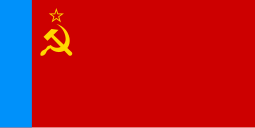 Flag of the Russian SFSR (1954–1991) | |
| Use | Civil and state flag, civil and state ensign |
|---|---|
| Proportion | 1:2 |
| Adopted | 9 January 1954 |
| Relinquished | 22 August 1991 (de facto) 1 November 1991 (de jure) |
| Design | |
| Designed by | Valentin Petrovich Viktorov |
 Reverse flag | |
| Proportion | 1:2 |
| Design | A red field with a light blue strip on the hoist side. |

The penultimate USSR-era flag was adopted by the Russian Soviet Federative Socialist Republic (RSFSR) in 1954 and used until 1991. The flag of the Russian SFSR was a defacement of the flag of the USSR. The constitution stipulated:
The state flag of the Russian Soviet Federative Socialist Republic (SFSR) presents itself as a red, rectangular sheet with a light-blue stripe at the pole extending all the width [read height] which constitutes one eighth length of the flag.
The symbol of the hammer and sickle represented the working class; more specifically, the hammer represented the urban industrial workers and the sickle represented the rural and agricultural peasants. The red star represented the Communist Party and Communism. The red of the flag represented revolution in general and the Russian Revolution in particular. The blue stripe symbolized the wide Russian skies and the waters of its seas and rivers.